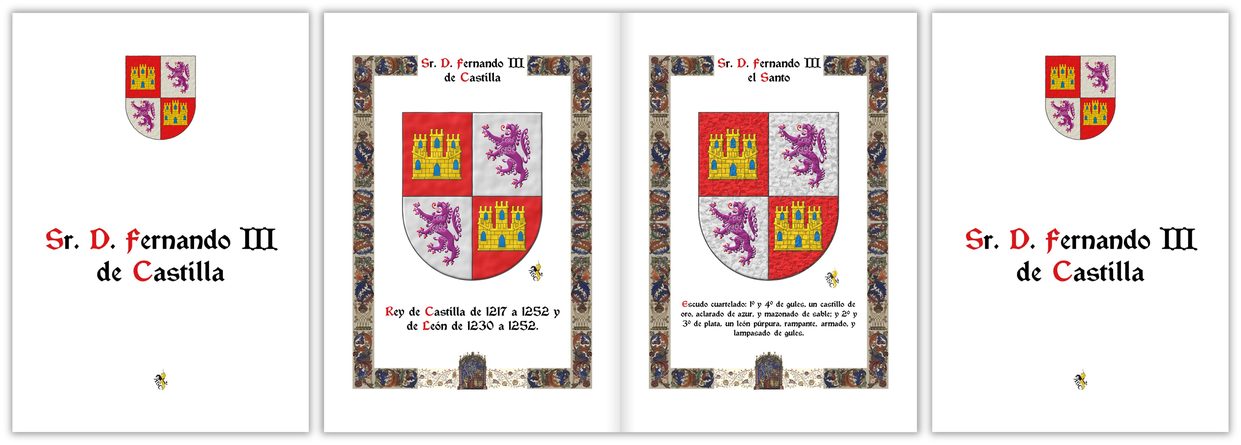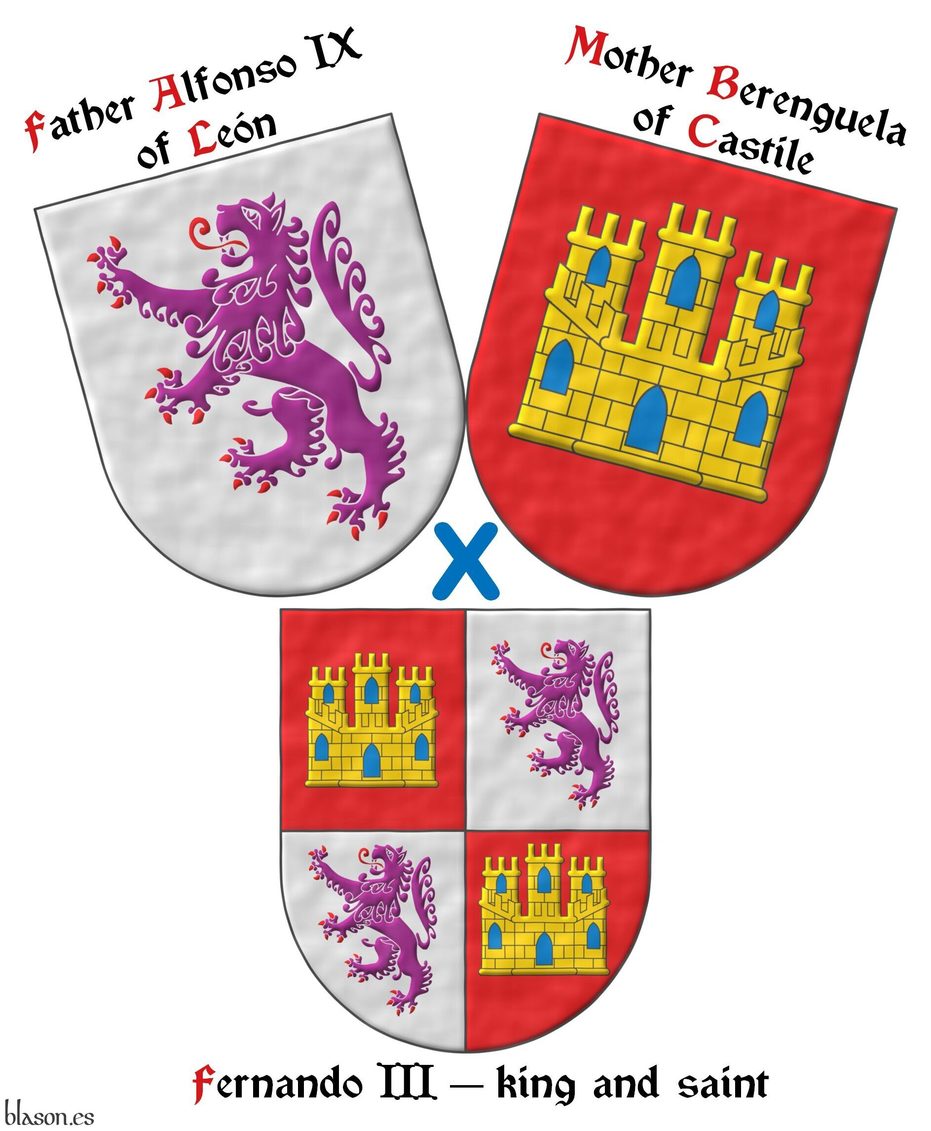Alphonse X of Castile
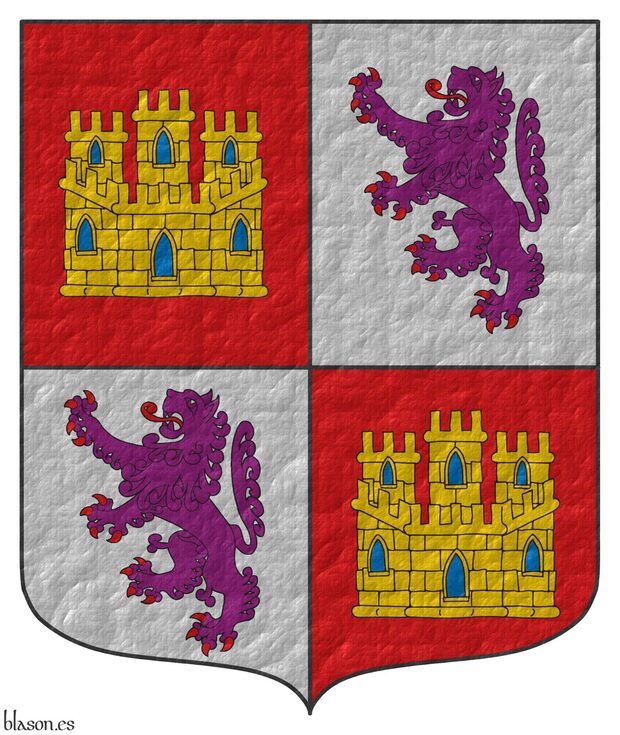
Known as the Wise, King of Castile and Leon from 1252 to 1284.
Escudo cuartelado: 1o y 4o de gules, un castillo de oro, aclarado de azur, mazonado de sable; 2o y 3o de plata, un león rampante de púrpura, armado y lampasado de gules.
Quarterly: 1 and 4 Gules, a castle triple towered Or, port and windows Azure, masoned Sable; 2 and 3 Argent, a lion rampant Purpure, armed and langued Gules.
Armories of the Wise King of Castile interpreted by me with the following characteristics: the external shape of the coat of arms ends in an ogee arch; the field, the 2 castles, and the 2 lions are outlined and enameled in flat colors; and the texture seems fabric.
This coat of arms, but with a pointed external shape, can be seen in the 2nd part of the so-called armorial [Wijnbergen; 1265; cuat of arms number 1,289], with the title «Le roy Despaingne», which in this context is understood to refer to Castilla y León.
The 2nd part of this armorial was made between 1270 and 1285 and, being Alphonse X king of Castile and Leon from 1252 to 1284, it is to Him that the title «Le roy Despaingne» seems to refer.
Blazon keywords: Quarterly, Gules, Or, Azure, Sable, One, Castle, Port and windows, Masoned, Argent, Purpure, Lion, Rampant, Armed and Langued.
Style keywords: Ogee, Plain tincture, Outlined in sable and Fabric.
Classification: Interpreted, Personal, Coat of arms and Kingdom of Castile and Leon.
Bearer: Alphonse X of Castile.

Alphonse X of Castile, open royal crown
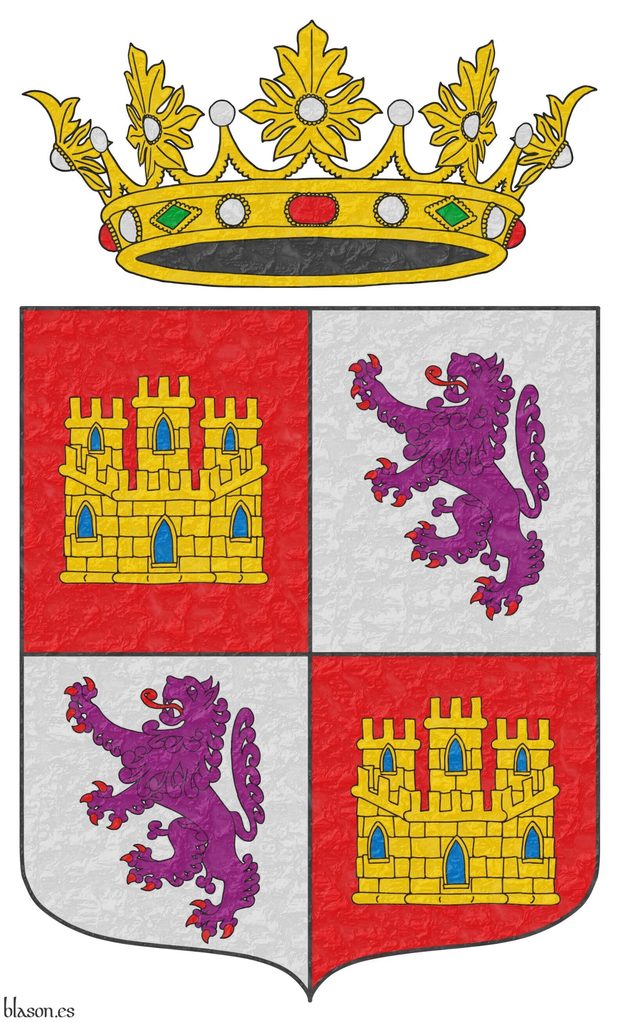
Escudo cuartelado: 1o y 4o de gules, un castillo de oro, aclarado de azur, mazonado de sable; 2o y 3o de plata, un león rampante de púrpura, armado y lampasado de gules. Timbrado de una corona real abierta.
Quarterly: 1 and 4 Gules, a castle triple towered Or, port and windows Azure, masoned Sable; 2 and 3 Argent, a lion rampant Purpure, armed and langued Gules. Crest: An open royal crown Or.
I emblazoned the coat of arms of the King with an external shape ending in an ogee arch, the field, castles, lions, and crown are outlined; and all have a crystal clear finishing.
Blazon keywords: Quarterly, Gules, Or, Azure, Sable, One, Castle, Port and windows, Masoned, Argent, Purpure, Lion, Rampant, Armed, Langued, Crest, Open royal crown and Crown.
Style keywords: Ogee, Plain tincture, Outlined in sable and Marmoreal.
Classification: Interpreted, Personal, Coat of arms and Kingdom of Castile and Leon.
Bearer: Alphonse X of Castile.


Ferdinand III of Castile
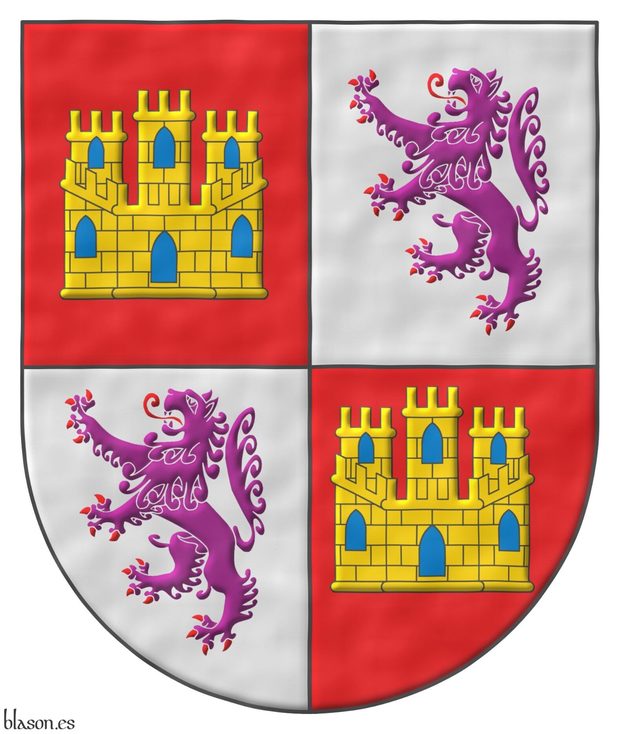
Son of Berenguela, Queen of Castile, and Alfonso IX, King of León.
Quarterly: 1 and 4 Gules, a castle triple towered Or, port and windows Azure, masoned Sable; 2 and 3 Argent, a lion rampant Purpure, armed and langued Gules.
Escudo cuartelado: 1o y 4o de gules, un castillo de oro, aclarado de azur, mazonado de sable; 2o y 3o de plata, un león rampante de púrpura, armado y lampasado de gules.
Arms of King Ferdinand III of Castile, as interpreted by me, with the following characteristics: the shield’s shape is rounded; the field, the two castles, and the two lions have been illuminated; and the whole composition features a watercolor finish.
It is with King Ferdinand III the Saint of Castile when «the emblematic system reaches its highest degree of perfection, acquiring two characteristics: realism, which becomes a hallmark of Spanish heraldry,... and the tendency to combine coats of arms» with the appearance of quarterly divisions replacing the cadency marks used in the rest of Europe [Valverde Ogallar, P. B.; 2001; page 100].
Shield in flat ink and illuminated metallic finish
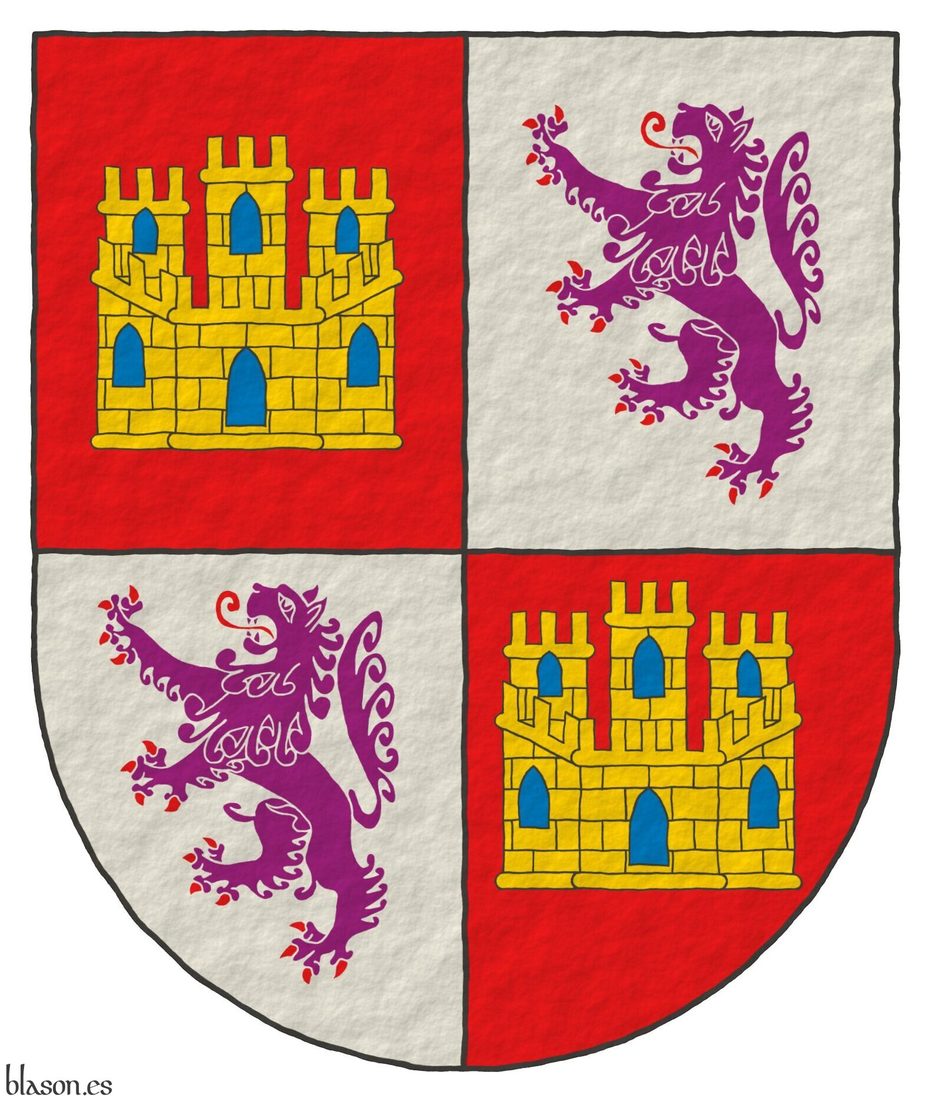
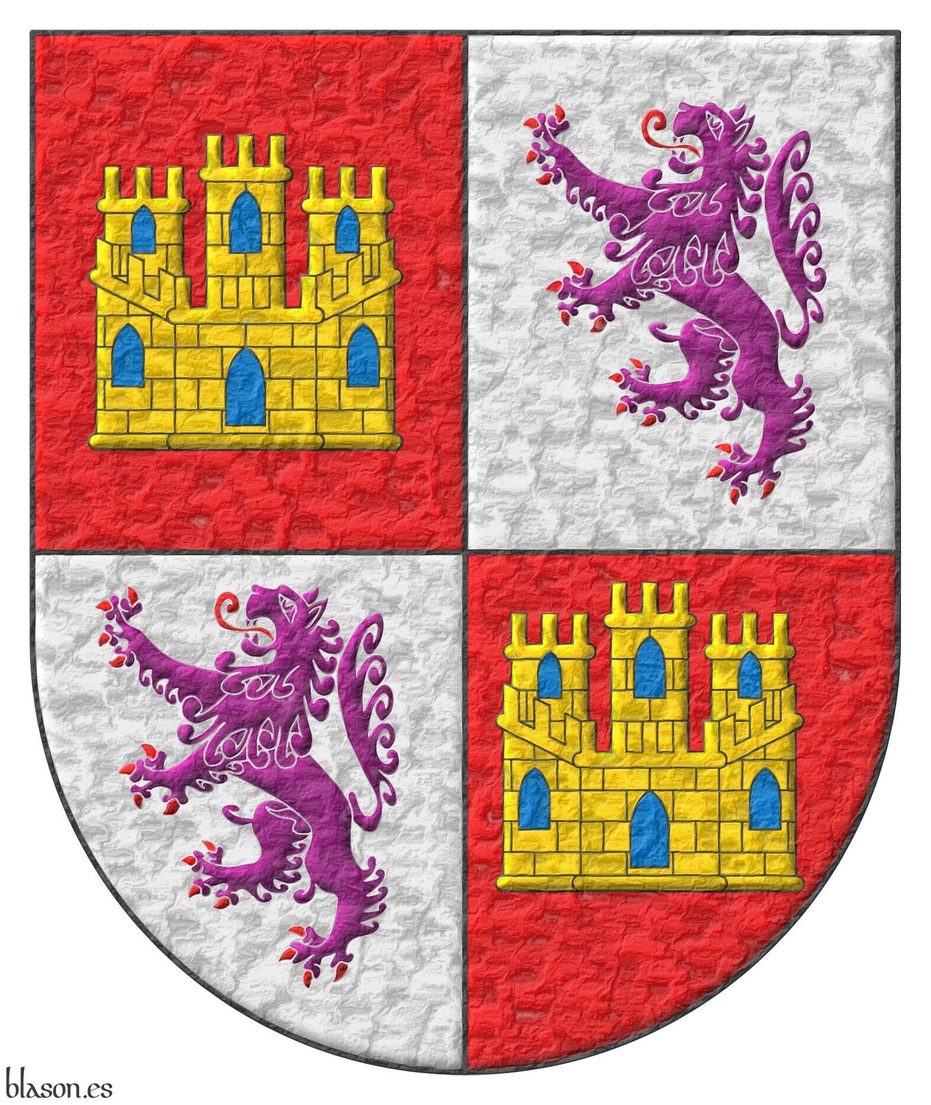
Design of a heraldic document
Blazon keywords: Quarterly, Gules, Or, Azure, Sable, One, Castle, Port and windows, Masoned, Argent, Purpure, Lion, Rampant, Armed and Langued.
Style keywords: Semi-circular, Illuminated and Watercolor.
Classification: Interpreted, Personal, Coat of arms and Kingdom of Castile and Leon.
Bearer: Ferdinand III of Castile.


Ferdinand III of Castile, open royal crown
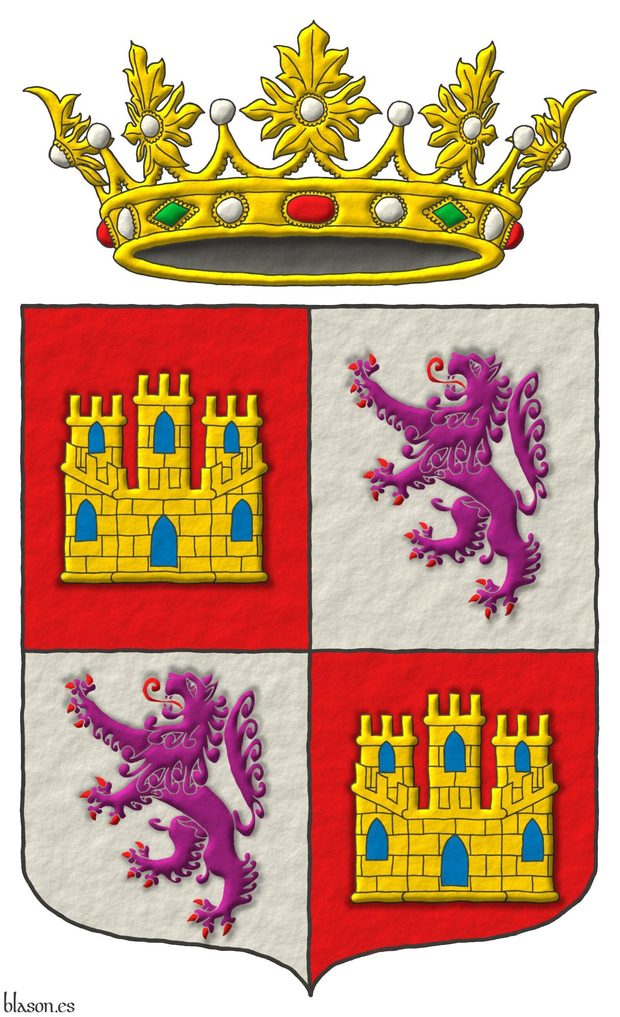
King of Castile from 1217 to 1252 and of León from 1230 to 1252.
Quarterly: 1 and 4 Gules, a castle triple towered Or, port and windows Azure, masoned Sable; 2 and 3 Argent, a lion rampant Purpure, armed and langued Gules. Crest: An open royal crown Or.
Escudo cuartelado: 1o y 4o de gules, un castillo de oro, aclarado de azur, mazonado de sable; 2o y 3o de plata, un león rampante de púrpura, armado y lampasado de gules. Timbrado de una corona real abierta.
Arms of the king, as interpreted as follows: the shield’s shape is pointed and rounded; the field, the castles, the lions, and the crown have been illuminated; only the castles and the lions have been shaded; and the whole composition features a raised-line finish.
Between the years 1217-1229, King Ferdinand III, before adopting this quarterly shield and when he was only King of Castile, in his seals «bears the arms of Leon (family arms) on the shield of the equestrian image and carries on the reverse the emblem of Castile (territorial sign)» [Menéndez Pidal de Navascués, F.; 1988; page 537].
Blazon keywords: Quarterly, Gules, Or, Azure, Sable, One, Castle, Port and windows, Masoned, Argent, Purpure, Lion, Rampant, Armed, Langued, Crest, Open royal crown and Crown.
Style keywords: Ogee, Illuminated, Shaded and Freehand.
Classification: Interpreted, Personal, Coat of arms and Kingdom of Castile and Leon.
Bearer: Ferdinand III of Castile.


Ferdinand III, invention of quartering
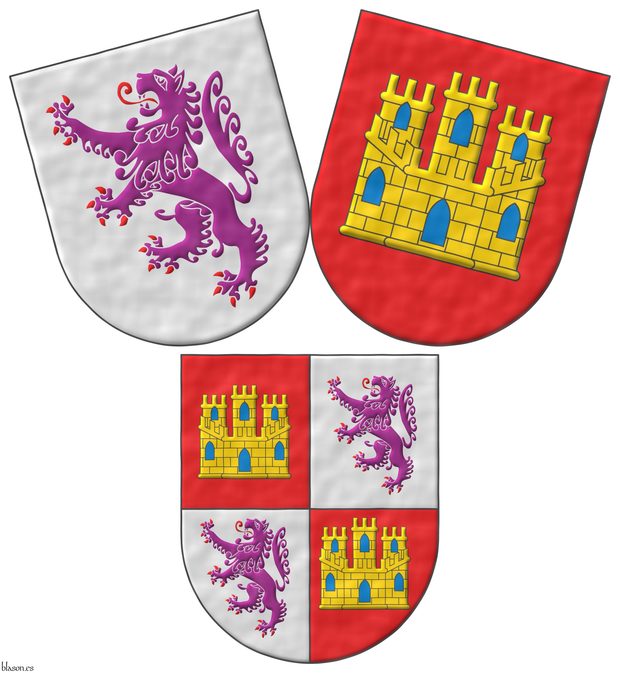
Quarterly: 1 and 4 Gules, a castle triple towered Or, port and windows Azure, masoned Sable; 2 and 3 Argent, a lion rampant Purpure, armed and langued Gules.
Escudo cuartelado: 1o y 4o de gules, un castillo de oro, aclarado de azur, mazonado de sable; 2o y 3o de plata, un león rampante de púrpura, armado y lampasado de gules.
A symbolic image representing, through 3 coats of arms, the creation of the coat of arms of the King Ferdinand III the Saint from the arms of Alfonso IX, King of León, and Berenguela, Queen of Castile. The shapes of all three shields are rounded; all their components are illuminated; and the whole composition features a watercolor finish.
Ferdinand III the Saint was the son of Alfonso IX of León and Berenguela of Castile. During his reign, the crowns of Castile and León were united forever. When, in 1230, Ferdinand III succeeded his father, he adopted a quarterly coat of arms, placing his mother's arms, the castle, in the 1st and 4th quarters, and his father's arms, the lion, in the 2nd and 3rd quarters. His goal was likely to achieve balance between the two kingdoms and to give his coat of arms a greater sense of continuity over time compared to impaled arms. The coat of arms of Ferdinand III the Saint was the first quarterly shield in history, and the idea spread into the heraldry of Spain and other kingdoms, such as Aragon-Sicily, Brabant, England, Navarre, and Bohemia.
The mother first, schematic in English
Blazon keywords: Quarterly, Gules, Or, Azure, Sable, One, Castle, Port and windows, Masoned, Argent, Purpure, Lion, Rampant, Armed, Langued, Crest, Open royal crown and Crown.
Style keywords: Semi-circular, Illuminated, Tilted shield and Watercolor.
Classification: Interpreted, Personal, Accolé arms, Family tree, Genealogical, Kingdom of Castile, Kingdom of León and Kingdom of Castile and Leon.
Bearer: Ferdinand III of Castile.


![Ver [Brault, G. J.; 1997] en referencias bibliográficas. Libro abierto, hojas de plata, filo de oro, guardas de gules, tapas de sable.](../css/Libro.Bibliografia.png)
Brault, G. J.; 1997
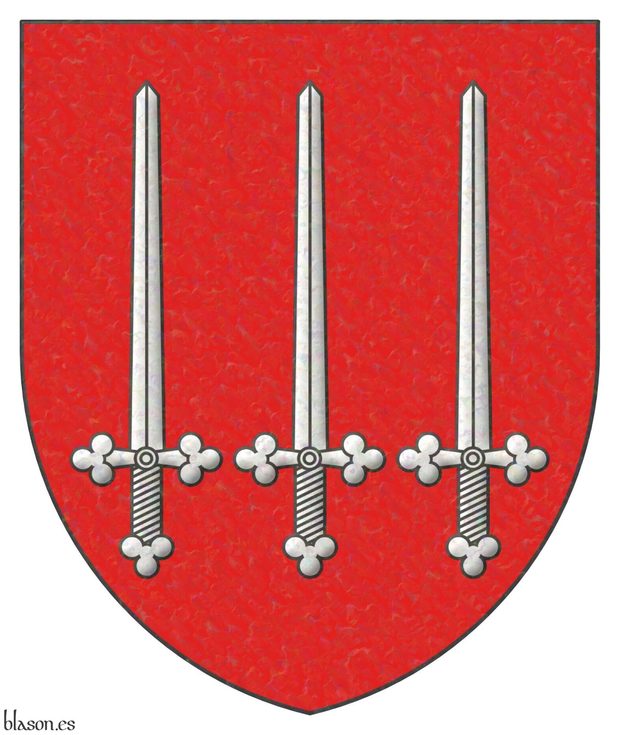
Gerard J. Brault, professor of French and Medieval Studies at Pennsylvania State University, «Rolls of Arms of Edward I, 1272-1307, Volume I and Volume II», is a set of 2 volumes, 1,104 pages, size 24.4 x 17.2 cm, with 3 color illustrations and 8 black and white illustrations, published by Boydell Press, Aspilogia series, ISBN 9780851156699, Suffolk, United Kingdom, May 1, 1997.
Another annotated edition exists from February 21, 2008, also published by Boydell Press.
The starting hypothesis of this book is that at the beginning of the second half of the 13th century, the use of coats of arms increased, this increase led to the appearance of the first armorials in which the names of their holders were recorded along with the descriptive blazon of their armory, and painted shields could be included.
From the Middle Ages, about 350 armorials have survived, of which 130 come from England, and they are a unique source for identifying many medieval figures, their titles, and their possessions. This book analyzes 17 of these armorials, such as the so-called [Marshal, L.; 1295; The Lord Marshal's Roll], which includes the coat of arms of William de Colebrand that illustrates this bibliographic reference.
Bibliographical reference of century XX.
Author: Brault, Gerard J..
Here are the articles quoting this reference:
External link:


![Ver [Menéndez Pidal de Navascués, F.; 1988] en referencias bibliográficas. Libro abierto, hojas de plata, filo de oro, guardas de gules, tapas de sable.](../css/Libro.Bibliografia.png)
Menéndez Pidal de Navascués, F.; 1988
Faustino Menéndez Pidal de Navascués, «Spanish Heraldic Panorama: Epochs and Regions in the Medieval Period», paper presented at the I Seminar on Heraldry and Genealogy, organized by the Zurita Chair of the Institución Fernando el Católico, in Zaragoza, on December 14 and 15, 1984, published in I Seminar on Heraldry and Genealogy, publication number 1.138 of the Institución Fernando el Católico, pages 5-21, Zaragoza, 1988.
Also published later in the Revista Príncipe de Viana, ISSN 0032-8472, year number 68, issue number 241, dedicated to the tribute to Faustino Menéndez Pidal de Navascués, pages 533-553, Government of Navarra, Institución Príncipe de Viana, Pamplona, 2007.
Bibliographical reference of century XX.
Author: Menéndez Pidal de Navascués, Faustino.
The following articles cite this bibliographic reference:
External link:
Internal resources: MenendezPidalDeNavascuesF1988.PanoramaHeraldicoEspanolEpocasYRegionesEnElPeriodoMedieval.pdf.


Alfonso IX of Leon
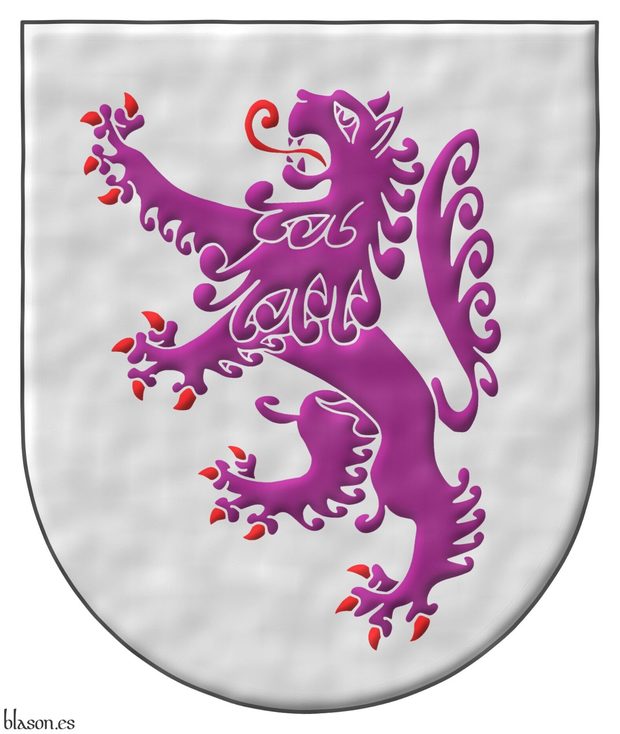
Born on August 15, 1171, in Zamora and died on September 24, 1230, in Sarria, Lugo.
Argent, a lion rampant Purpure, armed and langued Gules.
Escudo de plata, un león rampante de púrpura, armado y lampasado de gules.
Arms of the king of León interpreted by me as follows: the escutcheon is in a semi-circular arch; the field and the lion have been enameled and illuminated; and the ensemble has a watercolor finish.
This coat of arms of León can be seen, among many other places, for example, in [Argote de Molina, G.; 1588; chapter XLII].
Blazon keywords: Without divisions, Argent, Purpure, Gules, One, Lion, Rampant, Armed and Langued.
Style keywords: Semi-circular, Illuminated, Outlined in the field tincture and Watercolor.
Classification: Interpreted, Personal, Coat of arms and Kingdom of León.
Bearer: Alfonso IX of Leon.

Continue with: Alfonso IX of Leon, open royal crown.
-
Language
-
Categories of heraldry
-
Divisions of the field
- Without divisions
- Party per pale
- Party per fess
- Party per bend
- Party per bend sinister
- Tierce
- Tierce sinister
- Tierced per pale
- Tierced per fess
- Tierced per bend
- Tierced pallwise inverted
- Quarterly
- Quarterly per saltire
- Gyronny
- Party per fess, the chief per pale
- Party per pale, the sinister per fess
- Party per fess, the base per pale
- Party per pale, the dexter per fess
- Chapé
- Chaussé
- Embrassé
- Contre-embrassé
- Party per chevron
- Enté
- Enté en point
- Flanched
-
Metals
-
Colours
-
Furs
-
Other tinctures
-
Ordinaries and sub-ordinaries
-
Diminutives of the ordinaries
-
Other charges
-
Inanimate charges from Nature
Atom, Crescent, Diamond, Emerald, Estoile, Increscent, Lightning flash, Moon, Mount, Mullet, Mullet of four points, Orbital, Plough of Ursa Major, Rainbow, Ray of the sun, River, Sea, Snowflake, Sun, Sun in splendour, Trimount and Water.
-
Vegetal charges from Nature
Acorn, Apple, Apple tree, Ash, Bluebonnet, Camellia, Chrysanthemum, Cinquefoil, Cornflower, Dogwood flower, Double rose, Elm, Fleur de lis, Flower, Holm oak, Hop cone, Kapok tree, Laurel, Lily, Linden, Lotus flower, Madonna lily, Oak, Olive tree, Palm tree, Pomegranate, Poplar leaf, Rose, Shamrock, Sunflower, Thistle, Tree, Tulip, Vine and Wheat.
-
Animal charges from Nature
Badger, Bald eagle, Barbel, Barn owl, Bear, Beaver, Beetle, Bighorn sheep, Blackbird, Boar, Brach hound, Bull, Doe, Dog, Dolphin, Dove, Eagle, Elephant, Falcon, Fish, Flame, Fly, Fox, Frog, Goat, Goldfinch, Goose, Heron, Horse, Hummingbird, Jaguar, Lark, Leopard, Lion, Lion passant, Lion rampant guardant, Lioness, Lynx, Male figure, Martlet, Merino ram, Owl, Panther, Parrot, Peacock, Pelican, Pelican in her piety, Puffin, Quetzal, Raven, Roe deer, Rooster, Savage, Seagull, Serpent, She-wolf, Stag, Starling, Tyger, Vulture, Warren hound and Wolf.
-
Parts of natural charges
Arm, Beak, Branch, Caboshed, Chest, Claw, Covert, Dorsal fin, Eagle claw, Ermine spot, Escallop, Feather, Foot (palmiped), Foreleg, Forepaw, Hand, Head, Heart, Hoof, Leaf, Neck, Ostrich feather, Palm frond, Paw, Roe deers' attires, Shoulder, Sprig, Stags' attires, Stem, Swallow-tail, Tail, Tail addorsed, Tail fin, Talon, Tooth, Trunk, Trunk (elephant), Two hands clasped, Two wings in vol, Udder, Wheat spike, Wing and Wrist.
-
Artificial charges
Ace of spades, Anchor, Anvil, Arch, Arm vambraced, Armillary sphere, Arrow, Axe, Bell, Bell tower, Beret, Bonfire, Book, Bookmark, Bow, Bridge, Broken, Buckle, Cannon, Cannon dismounted, Cannon port, Carbuncle, Castle, Celtic Trinity knot, Chain, Chess rooks, Church, Clarion, Clay pot, Closed book, Club, Comb, Compass rose, Conductor's baton, Cord, Covered cup, Crozier, Crucible, Cuffed, Cup, Cyclamor, Dagger, Double vajra, Drum, Ecclesiastical cap, Fanon, Federschwert, Fleam, Four crescents joined millsailwise, Galician granary, Garb, Gauntlet, Geometric solid, Grenade, Halberd, Hammer, Harp, Host, Hourglass, Key, Key ward, Knight, Knot, Lantern, Letter, Line, Loincloth, Menorah, Millrind, Millstone, Millwheel, Monstrance, Mortar, Mullet of six points pierced, Nail, Non-classic artifact, Norman ship, Number, Oar, Oil lamp, Open book, Page, Pair of scales, Parchment, Pestle, Piano, Plough share, Polish winged hussar, Portcullis, Potent, Quill, Ribbon, Rosette of acanthus leaves, Sabre, Sackbut, Sail, Scroll, Scythe, Sheaf of tobacco, Ship, Skirt, Spear, Spear's head, Star of David, Sword, Symbol, Tetrahedron, Torch, Tower, Trident, Trumpet, Turret, Two-handed sword, Wagon-wheel, Water-bouget, Wheel, Winnowing fan and With a turret.
-
Immaterial charges
Angel, Archangel, Basilisk, Dragon, Dragon's head, Garuda, Golden fleece, Griffin, Heart enflamed, Mermaid, Our Lady of Mercy, Ouroboros, Paschal lamb, Pegasus, Phoenix, Sacred Heart of Jesus, Saint George, Sea-griffin, Trinity, Triton, Unicorn, Winged hand and Wyvern.
-
External elements
-
Heraldic creations
-
References
-
Formats
-
Keywords on this page
Port and windows, Watercolor, Alfonso IX of Leon, Alphonse X of Castile, Point upwards, Armed, Azure, Bibliography, Castle, Crest, Ogee, Crown, Open royal crown, Quarterly, Outlined in sable, Outlined in the field tincture, In fess, Fabric, Coat of arms, Accolé arms, Sword, Ferdinand III of Castile, Genealogical, Personal, Gules, Illuminated, Interpreted, Langued, Lion, Marmoreal, Masoned, Semi-circular, Metal beaten, Or, Argent, Without divisions, Purpure, Rampant, Kingdom of Castile, Kingdom of Castile and Leon, Kingdom of León, Tilted shield, Sable, Century XX, Shaded, Plain tincture, Freehand, One and Family tree.
